A KWL, 'Know, Want to Know, Learned' chart is instructional employed to help students navigate through the text. The strategy is utilized to gauge the things students need to learn and those that students have understood and learned. The Internet makes it super easy to find out just about anything you want to know. In fact, it's often way too easy to get lost in a vast ocean of details and forget how you ended up there. Teach your students beginning critical thinking skills by helping them identify a starting point, a specific set of answers to acquire, and a review of the knowledge they gained when they are introduced to new material. Teach your students how to frame their research and reading. Because scratching a mental itch can be just as satisfying as scratching a real one.
Printable KWL Charts
Click the buttons to print each organizer.
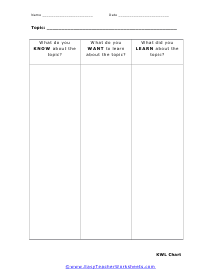
Standard KWL Chart
Help students identify starting and ending points for researching a given topic. This is an oldie, but a goodie. Sometimes the best answer is the simplest one.
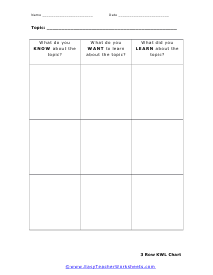
3 Row KWL Chart
The same as above, but with an extra row for more detailed analysis of the material. This can allow you to psuh into more concepts.
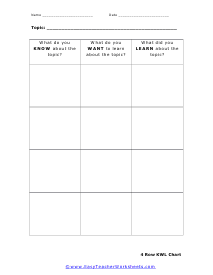
4 Row KWL Chart
Four rows allow students to more specifically identify avenues of research about a given topic. Many science teachers tend to use this format.

5 Row KWL Chart
Five rows allow students to more specifically identify avenues of research about a given topic. Still plenty of room to work with here.
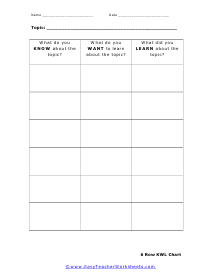
6 Row KWL Chart
Six rows allow students to more specifically identify avenues of research about a given topic.
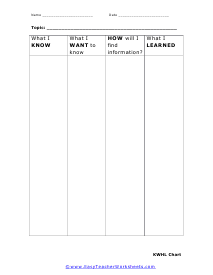
Standard KWHL Chart
This chart adds a column which allows the student to identify how they will pursue the answers. This adds an element of research based thought process for students.
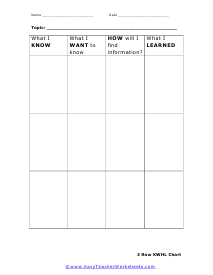
3 Row KWHL Chart
The same as above, but with an extra row for more detailed analysis of the material. You can also use those extra rows to cite evidence or sources.
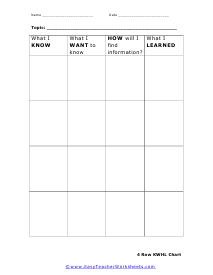
4 Row KWHL Chart
Four rows allow students to more specifically identify avenues of research about a given topic.
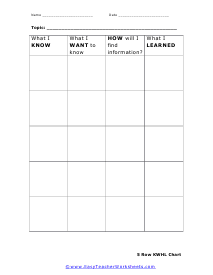
5 Row KWHL Chart
Five rows allow students to more specifically identify avenues of research about a given topic.
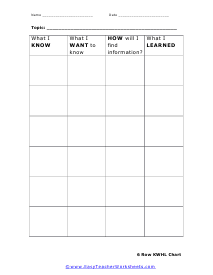
6 Row KWHL Chart
Six rows allow students to more specifically identify avenues of research about a given topic.
How to Use KWL Charts with Students
KWL charts are simple graphic organizers that help students organize information before, during, and after a lesson. They're easy to implement and effective at enabling young knowledge seekers to own their learning. On the other hand, they're a great lesson planning tool for teachers.
What Are They?
The abbreviation "KWL" refers to three distinct facets of learning. The "K" stands for "Know," the "W" for "Want to Know," and the "L" for "Learned." In essence, students can divide any lesson into what they already "know" about the topic (K), what they want to understand and learn about it (W), and what they've learned during a lesson (L).
The chart comprises of three columns, each depicted by one of the alphabets. Other than being an excellent planning tool, a KWL chart can help students engage themselves thoroughly with the learning process. They can easily recall the knowledge acquired about a particular topic and keep an eye on their overall progress. Reading comprehension is another area where students can improve quickly using KWL charts.
First, a chart is developed consisting of three columns, namely, Know, Want to Know, and Learned. Next, the students ponder over the things that they know about a certain topic. These things are listed or recorded in the K (Know) column of the charts students then develop questions about what they want to know about certain topics, which are placed in the W (Want to Know) column of the chart. Lastly, the students go through the given text or passage and are asked to respond to the questions they have recorded in the W (Want to know) column of the chart. Their answers and responses to their developed question are then included in the L (Learned) column of the charts it means that students have learned the things they wanted to know about a certain topic.
KWL charts help the instructional strategies in numerous ways. For example, the chart helps elicit prior knowledge about a certain topic, identify the purpose of reading a text, and allow the student to gauge their understanding of a topic.
The Benefits of Using KWL Charts
While they're a relatively simple tool, both students and teachers can obtain multiple benefits from using KWL charts. Some of them are listed below.
- KWL charts are super-easy to use.
- They identify students' knowledge level about a particular topic. Teachers can compare this data with the learning objectives to identify the gaps in students' understanding.
- KWL charts motivate students to learn more about a subject and improve their knowledge base.
- Teachers can track their pupils' progress and ensure that work is being done to attain the learning objectives.
- They are a highly organized way of taking lecture notes.
- The flexibility of KWL charts enables teachers and students to use them for any subject and any topic. In particular, teachers can adapt their lessons to meet the students' needs based on provided info about what the kids already know.
The simplicity of KWL charts makes them an obvious choice for teachers and students alike. By maintaining a record of every stage of the learning process (existing knowledge base, what needs to be learned, and what has been known), teachers can pinpoint their students' needs and plan lessons accordingly.
Similarly, students can significantly use a KWL chart to enhance their understanding of a subject/topic they've previously struggled in.
How to Use Them
The process is quite simple. You've got three columns (K, W, & L) to fill. Below is a hypothetical KWL chart for teachers. The term "XYZ" denotes a particular topic.

Column 1: K (What You Think Your Students Know)
In this section, you can jot down everything your class already knows about the topic. Even if they haven't mastered something but have an idea about it, you can mention that in this column.
Column 2: W (What You Want Your Students to Know)
When column 1 is done, you need to consider the learning objectives that you've set for your students. Everything you want them to learn about the topic under consideration will be mentioned here.
Column 3: L (What Your Students Have Learned)
After a lesson, everything that your students have learned can be added to this column.
Final Words
KWL charts are a straightforward yet highly effective planning and learning tool. Teachers can use it to facilitate their students' learning, while the young knowledge seekers can also use it on their own to improve their knowledge base about any topic or subject.

